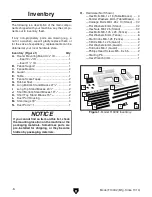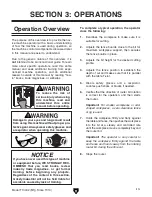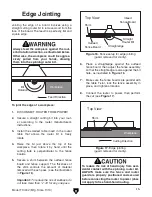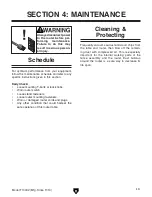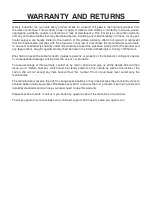
model t10432 (mfg. since 11/10)
-15-
Edge Jointing
Jointing the edge of a board involves using a
straight cutting router bit to remove wood from the
face of the board. the result is a perfectly flat and
square edge.
To joint the edge of a workpiece:
1. disConneCt router From poWer!
2. secure a straight cutting bit into your rout-
er according to the router manufacturer's
instructions.
3. install the smallest table insert in the router
table that allows the router bit to freely
rotate.
4. raise the bit just above the top of the
workpiece, then rotate it by hand until the
cutting flute is perpendicular to the fence
boards.
5. secure a shim between the outfeed fence
board and fence support. the thickness of
the shim controls the amount of material
removed with each pass. (see the illustration
in
figure 16).
important:
To reduce the risk of kickback, do
not take more than
1
⁄
8
" off for any one pass.
Straightedge
Shim
Outfeed
Fence Board
Straight
Router Bit
Infeed
Fence Board
Top View
figure 16. Fence setup for edge jointing
(guard removed for clarity).
6. place a straightedge against the outfeed
fence board, then adjust the fence assembly
so that the straightedge is also against the bit
flute, as illustrated in
figure 16.
7. make sure the fence boards are parallel with
the table t-slot, lock the fence assembly in
place, and tighten all knobs.
8. Connect the router to power, then perform
the cut (see
figure 17).
Top View
Cutting Direction
Shim
Workpiece
figure 17. edge jointing
(guard removed for clarity).
Workpiece
Feed Direction
Bit
Rotation
Always feed the workpiece against the rout-
er bit rotation direction, as illustrated below.
Otherwise, the workpiece could be aggres-
sively pulled from your hands, drawing
them into the spinning router bit.
To reduce the risk of hand injury from acci-
dental contact with the spinning router bit,
ALWAyS make sure the fence and router
guard are properly positioned and secured
before connecting the router to power (does
not apply to free hand-hand routing.








